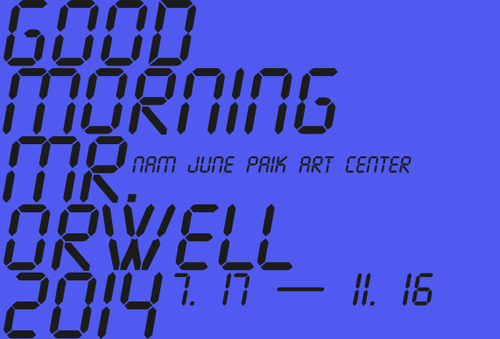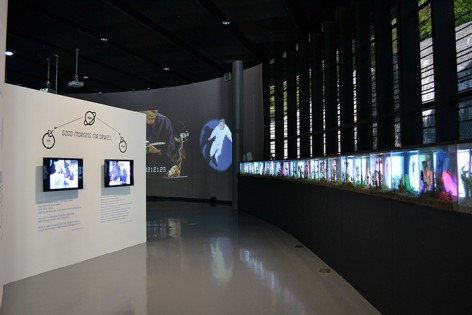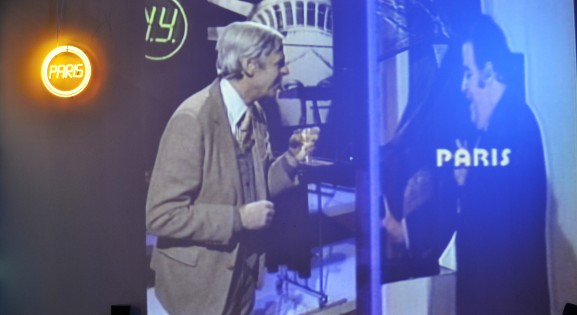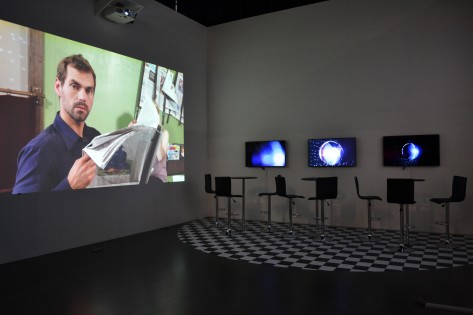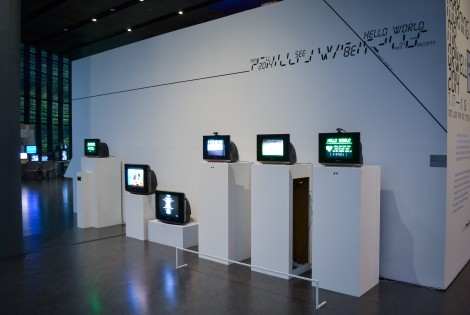must be accompanied by the protection of the culture
of the weak or by the creation of a diverse software skillfully
bringing to life the qualitative differences in various cultures.
– Nam June Paik, Art & Satellite (1984)
In 1949, George Orwell published a dystopian novel 1984 depicting a dark future in which surveillance and control by tele-communication become a routine, and made a pessimistic prediction that humans will be controlled by mass media in 1984.
As a refutation of Orwell’s prediction, Nam June Paik said, “You were only half right” and directed the satellite TV show Good Morning, Mr. Orwell to show the positive utilization of mass media by means of art. On January 1, 1984, Paik linked New York and Paris live via satellite in collaboration with around 30 teams, 100 artists and 4 broadcasters and aired music, fine arts, performance, fashion show and comedy that cross the borderline between popular and avantgarde art in real time. Above all, these various genres of arts were edited and displayed on one TV screen. This show was broadcast live in New York, Paris, Berlin, Seoul, etc. and is estimated to have been watched by over 25 million TV viewers.
Now, the year 2014, is the time to look into the eyes of ourselves seeing this positive festival in commemoration of the 30th anniversary of Good Morning, Mr. Orwell. Today’s global networking system using the internet beyond satellite makes both stronger controls and broadened freedom possible. This exhibition is intended to ask about the possibility of making a new node and link to change this network as well as to pose a question of control/freedom that becomes more complicated and secret day by day.
- Exonemo, DesktopBAM
- Taiyun Kim& Ji Hyun Yoon, Hello, World!
- Pauline Oliveros, Rock Piece, King Kong Sing Along Simultaneously
- Thursday, 17 July 2014
– 15:15 Hapjeong Subway Station (Exit #2)
– 16:00 Hannam-dong across from Hannam - The Hill (the former site of Dankook Univ.)
For free shuttle bus reservation, please email to
reservation@njpartcenter.kr
- 10am—7pm
- Closed on every 2nd & 4th Monday of the month

George Orwell Archives
Space Design_Remove Architecture

Remove Architecture, Psynopticon, 2014, lighting, dimensions variable
In the Panopticon, which is devised as a model prison allowing a person to observe many people, the most important factor is the ‘psychology’ of a person to be observed. Under the condition of not being able to see the observer, the anxiety that one is being watched by the observer and self regulation become the most effective means of control. This principle of Panopticon is also easily found in our daily life. The artist makes a pattern of Panopticon by using something visible and invisible, and light and shadow. Viewers entering this pattern created by the repetition of the forms of ordinary objects in the form of concentric circle become observers and those being observed at the same time before they know it.

Finger Pointing Worker, Pointing at Fukuichi Live Cam, 2011, 1 channel video, color, sound, 24min 50sec video : Tokyo Electric Power Co. editor : Kota Takeuchi
This video work by ‘Finger Pointing Worker’, an unidentified artist, is a recording of the video images from ‘Fukuichi Live Camera’ installed by Tokyo Electric Power Company to show the sites in real time through the internet at the time of the Fukushima earthquake. The artist went to the site and made a parody gesture of Centers, a representative piece of narcissism by Vito Acconci, in front of the camera transmitting live via internet, wearing the uniform of the nuclear power plant workers. And another artist Kota Takeuchi filmed this scene. By showing aggressive and narcissistic gestures, the artist criticizes the ones who do not realize a critical situation and the situations where the workers are not informed of the danger of the nuclear power plant and their sacrifices are heroized.
Man with a Video Camera, 1988, 1 channel video, color, sound, 6min 3sec
Reverse Big Brother, 1990, 1 channel video, color, sound, 1min
Video artist Paul Garrin, who also worked closely with Nam June Paik for many of Paik’s pieces as a collaborator, has proved the diversity of video synthesizing, as well as the power of recording and reporting that home video camera has. The artist shot the scenes of riots and the irrationality of the society with his home video camera, and his tape with footage of violent police suppression and willful actions against photographing was broadcast on television and caused quite a stir.

Mona Hatoum, So Much I Want to Say, 1983, 1 channel video, b&w, sound, 5min
A man stops the mouth of the artist, who tries to say something, with his hands. Although the video is slow and keeps cutting out, one can continuously hear the voice repeating the title. In this video, performance is recorded utilizing the ‘slow scan’ technique and the images are transmitted to other places via satellite. With the slow scan technology, images are transmitted every 8 seconds, but the sound is transmitted through the telephone lines uninterruptedly. Using the technology to transmit both discontinuous images and continuous sounds to a distant place, the artist shows the energy of resistance to constantly transmit the voice even in the suppressed and limited situations.ir.

Lee Boorok, Warvata_Sticker Project, 2005~2014, print on vinyl sticker, 300 x 450cm, 120 x 480cm
Warvata, a compound word of ‘War’ and ‘Avatar’, is composed of pictograms, a pictorial symbol which is easy and clear to recognize for everyone. Since 2005, the artist has worked on the sticker project: he produced Warvata’s pictograms in sticker, distributed or mailed them to people, and then had people put the stickers on the existing signs or images, take a picture of it, and send them back to the artist. The scenes in which war, an extreme tragedy, becomes a common thing that everybody can recognize and it travels all over the world in the form of sticker, which is a capitalistic method of communication to be copied on a large scale, make people feel horrified from the daily routine. However, the process that the images are created by putting the Warvata stickers on a certain space and they come back to the artist one by one proves a sparkling satire and the power of participation.
Actors_ Hanchang Lim, Jung-geun Park
The court ruled that P violated the National Security Law by retwitting the news about North Korea. However, the statements of the three parties — the court, P and people around P — were completely different from one another. With a doubt that the reason why P’s intention had not been deliver
Movie director as well as video artist Sompot Chidgasornponse, who also has worked with Thai movie director Apichatpong Weerasethakul as an assistant director, made the movie Syndromes and a Century together with him. Some of the scenes in this movie had to be cut in Thailand, so Chidgasornponse created another piece of video from the expurgated scenes along with the reasons given by the authority for censoring with a slightly different title. Even though one sees this video based on the reasons of being censored, it is difficult to understand why it became the object of censorship. The assertive sentences making a contrast with Weerasethakul’s poetic and vague images suggest the arbitrariness and injustice of censorship. Besides, it proves the power of art that cannot be controlled by the institutional censorship in that eliminated parts became a piece of video art.
Paik’s drawing Rendez-vous Céleste was inspired from the Altair and the Vega. The dim electric signals of each side station, New York and Paris, encounter in the air. This means the meeting of the stars of the century beyond time and space, which Paik continuously pursued.

Nam June Paik, Good Morning Mr. Orwell, 1984, 1 channel video, color, sound, 60min
Good Morning, Mr. Orwell was a live satellite TV show linking New York and Paris. Artists including Laurie Anderson, Allen Ginsberg, Charlotte Moorman and Thompson Twins had a live performance with the show host George Plimpton in New York, while Claude Villers hosted the show in which Sapho, Joseph Beuys, Urban Sax, etc. performed in Paris. Starting from the scene of the two hosts making a toast, a variety of performances made an interactive feedback by giving and taking, and they were melted into one screen. The exhibition ≪Good Morning, Mr. Orwell 2014≫ displays the main performance pieces in one space for audiences to experience the simultaneous and interactive characteristics of the performance Good Morning, Mr. Orwell.
Lorenzo Bianda was an official photographer for the New York Studio of Good Morning, Mr. Orwell. He recorded vivid scenes of the site including the expressions of stars in the waiting room, the atmosphere of the studio before and after the live show recording, staff meetings as well as the opening of the exhibition in ‘the Kitchen’ with his camera.
Paris version, 59min 53sec
Seoul version, 56min 53sec
In a spatial perspective, Good morning, Mr. Orwell was a broadcast program that spread to all over the world starting from New York and Paris, and in a temporal perspective, it is a live show transmitted starting from January 1, 1984 for around one hour in each country. In order to best demonstrate these characteristics, Nam June Paik preferred installation in which both versions of Good Morning, Mr. Orwell in New York and Paris are displayed together. In this exhibition ≪Good Morning, Mr. Orwell 2014≫, three types of Good Morning, Mr. Orwell in total — two versions broadcast in New York and Paris plus another one aired on KBS, 30 years ago — are presented. Materials with the analysis of detailed scenes in New York and Paris are available for audiences to compare and appreciate the shows from each country.
 Taiyun Kim & Ji Hyun Yoon, Hello, World!, 2014, multimedia installation, dimensions variable
Taiyun Kim & Ji Hyun Yoon, Hello, World!, 2014, multimedia installation, dimensions variableTaiyun Kim & Ji Hyun Yoon showcase a metadata performance Hello, World! that controls and visualizes the information collected from diverse channels and open the platform for its process to be connected to the exhibition space. By asking questions about the two sides of ‘Big Data’ in today’s world where everyone has his or her own channel, the artists lead the audience to realize how much information is shared and controlled and to manage the information for themselves at the same time.
The first part of the archives consists of draft scenarios and cue sheets written by Nam June Paik and the interviews with producers such as Carol Brandenburg. The second part comprises articles and drawings related to the Good Morning, Mr. Orwell. Paik’s article including his profound thoughts, “Art and Satellite” as well as print work series “V-idea” produced in 1984 are also on display.
Until the internet is widely used, satellite was the only means of real-time communication of audio and video among the remote places. The artists including Nam June Paik, Liza Bear, and Douglas Davis exerted their inspirations and efforts to the utmost in experimenting new possibilities of satellite and applying them to art. Tele-communication Cafe is meant to introduce various attempts of the artists, starting from the end of 1970s and retrace the fundamental pleasure that long distance communication has and new dimensions of space and time these works have created.
Like a stereoscope, a device for viewing a pair of plane images as a single threedimensional image, the figure in this work reveals his divided self. This fictitious character by the name of Soho Eckstein is a typical Caucasian from Johannesburg, the capital of South Africa and the artist’s alter ego as well. This figure shows his desire to communicate by means of communication media such as telegraph, telephone, etc. on the fragmented scenes. This eighth piece of his ‘Drawings for Projection’ film series is an animation in which parts of the chaotic city of Johannesburg are fantastically connected.
 Bjørn Melhus, Deadly Storm, 2008, 3 channel video, color, sound, 7min
Bjørn Melhus, Deadly Storm, 2008, 3 channel video, color, sound, 7minEither by impersonating a typical TV character or by utilizing classic techniques to attract the viewers, Bjørn Melhus expresses the most essential attributes of mass media. In this video, he creates musical rhythms by repetitively editing the words and sounds to emphasize the urgency. The artist takes advantage of the elements of TV, regarding himself as the generation most affected by television while critically analyzing a range of techniques that mass media use for mass manipulation.
Laurie Anderson is an artist who pursues a new way of combining lyrics and music, and tries to find a new possibility of sound through diverse musical instruments. These trials became popular through her hit song O Superman released in 1981. Since then, she has held a unique position in experimental art and popular music together. She participated in two main performances in Good Morning Mr. Orwell, through which Nam June Paik sought for communication between art and pop culture. This exhibition displays the four videos that Nam June Paik edited with Anderson’s performance videos as well as installation work X1, X2.
Web art or net art is another form of art that Nam June Paik dreamed of through satellites and is open to anyone without space constraints. Artists make millions of people continually write sentences on the internet site, participate in composing stories of many artists starting from one story while the audience creates a structure of following the stories through the ‘link’, or introduce a wide array of methods of participation using the internet through the links. The audience can see the forms of cyber art directly through the computer screen in a space created in the form of internet cafe.
 Sanghee Song, Dawn of the Day: The City Dreaming of a Utopia, 2014, 1 channel video installation
Sanghee Song, Dawn of the Day: The City Dreaming of a Utopia, 2014, 1 channel video installationThe views of the city Sanghee Song filmed are familiar but unrealistic, and idealistic but somewhat incomplete. The sentences quoted from dystopian novels such as George Orwell’s 1984 and Aldous Huxley’s Brave New World and so on are overlapped on this unrealistic video. With Messiaen’s Quartet for the End of Time in the background, those that now disappeared and those created while dreaming of a new utopia appear and disappear like the scenes from the dream through the lighting moving on the drawings.
 Liz Magic Lazer, PR(Public Relations), 2013, 5 channel video installation, 17min
Liz Magic Lazer, PR(Public Relations), 2013, 5 channel video installation, 17minLiz Magic Lazer, who pays attention to the current political and social phenomena, makes performers involved in the sites like movie theaters, street interviews, or broadcast recordings and set the scene for these kinds of situations. A five-channel video installation work PR(Public Relations) to be presented in this exhibition is a kind of post-drama in which one man sitting in a cafe expresses his thoughts and opinions while watching a street interview situation for news. This piece reframes the influences of journalism and its mechanism on the public awareness into performance and video work.
 Exonemo, Supernatural, 2009-2014, multimedia installation
Exonemo, Supernatural, 2009-2014, multimedia installationA media artist duo Exonemo, consisting of two artists Sembo Kenseke and Akaiwa Yae, has shown a variety of media extension works including net art, sound video processing, software programming, live performance and installation since 1996. Supernatural is a video installation that sheds new light on the relations between digital and analogue, virtual and real space, and consciousness and unconsciousness in a experimental and humorous way by connecting their studio in Japan and the exhibition space through the internet.

Harun Farocki, Counter-Music, 2004, 2 channel video, color, sound, 25min
In this video, Harun Farocki, a documentary filmmaker and video artist, shows the relationship between today’s city and visual media through a parody of Dziga Vertov’s Man with a Movie Camera, a classic in film history. The scenes of many European cities come from the functional video images shot for security cameras, city planning, and traffic system management, etc. The artist creates a video essay by rhythmically editing these functional images and adding the phrases that contain philosophical reflection on city and sharp eyes on social network to it.
The artist made this video by editing CCTV footage recorded by the City Watch, while staying in Liverpool, England. In general, surveillance camera images that are not requested as evidence are kept for 31 days and then are deleted afterwards. Since they can be kept separately upon request as evidence, Jill Magid submitted a request letter for 31 days to the City Watch and received the video with the images of her in a red coat, wandering around the city. Through the request form for the preservation of evidence, which was written just like a love letter, she turns the surveillance system and public power into a personal story.















